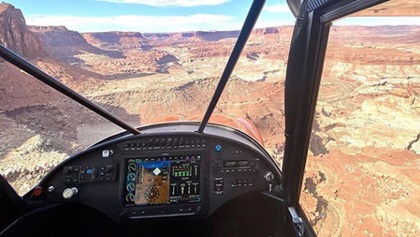Membership News & Notes: Legal Services Plan
You’ve got a lawyer: AOPA protects your flying life
Through the AOPA Legal Services Plan, Pilot Protection Services assists thousands of members each year with certificate-related legal issues. Led by attorney Jared Allen and overseen by General Counsel Justine Harrison, the Legal Services Plan team is staffed by five attorneys working alongside three administrative assistants/paralegals. Combined with AOPA’s network of almost 700 panel attorneys throughout the United States and Canada, our attorneys can help you navigate the legal complexities of alleged airspace violations, potential FAA enforcement actions, runway incursions, U.S. Customs matters, drug- and alcohol-related issues, and more.
The legal services team receives nearly 5,000 calls from members each year. These calls can address the legal complexities arising from tax matters; FAA enforcement; pilot deviations and compliance; accidents and incidents; NTSB reports and investigations; and aircraft and hangar document review for leases, purchases, and sales. There are two plans under the Pilot Protection Services umbrella: Basic and Plus. The Plus plan is necessary for any pilot who wants Legal Services Plan protection while exercising commercial privileges, but it’s also the best option for all pilots as it provides more hours with a panel attorney in the event of a matter covered by the Legal Services Plan.
“We have a higher renewal rate with our Plus members,” said Harrison. “And once in the plan, members tend to stay in.”
Legal Services Plan staff are available Monday through Friday, 8:30 a.m. until 6 p.m. (Eastern time). Call 800-872-2672 for the Legal Services Plan.
Email [email protected]
 MEET JUSTINE HARRISON: AOPA GENERAL COUNSEL
MEET JUSTINE HARRISON: AOPA GENERAL COUNSEL
Justine Harrison joined AOPA in 2019 and serves as AOPA’s general counsel and corporate secretary, leading the AOPA legal department and overseeing AOPA’s Legal Services Plan, which serves more than 67,000 members. Harrison is a commercial pilot and flies aircraft ranging from an AirCam experimental she co-built to a Lear 75. Harrison earned her bachelor of science degree from Cornell University, and her juris doctor from the William S. Boyd School of Law at the University of Nevada, Las Vegas. Prior to joining AOPA, Harrison ran her own law firm for a decade after serving as general counsel, senior vice president of external affairs, and corporate secretary of the Nevada Cancer Institute. She previously served as a director for the Nevada Cancer Institute, the Nevada Business Aviation Association, and Angel Flight West, and as a member of EAA’s Legal Advisory Council.
NOTES AOPA AIR SAFETY INSTITUTE
A long and winding road
Direct/Enter/Enter won’t work in the mountains
By Alicia Herron
Good flight planning is always important, but in the mountains it’s critical. During mountain flying, the airplane is closer to its performance limits, the pilot is closer to the limits of his or her skill, more things can go wrong, and there are fewer options in an emergency. Factors that increase risk even in flatland flying—such as density altitude, night, weather, and wind—can turn a normal mountain flight into a hazardous trip.
To help mitigate the increased risk, every mountain flight demands extensive flight planning, including careful route selection. In many cases, direct flights aren’t feasible in mountainous areas: Terrain can easily “out-climb” many light GA aircraft, and flying direct also limits your options in the event of an emergency.
Consider a flight through the Lake Tahoe area near the California/Nevada state line—which route would you choose? Depending on your aircraft, you could potentially climb over the mountains and fly direct. But is that the best choice? Now look at the long, circuitous route that hugs the shore of the lake before turning east through Spooner Summit Pass and then south to your destination. While longer (and requiring more navigation work), it offers lower terrain, nearby roads for emergency landings, and a large body of water for ditching. In the event of an engine failure, would you rather put the airplane down in a lake or take your chances on jagged, snow-capped peaks?
The technology we have today is incredible—our smartphones can operate as powerful navigation tools and, for many, paper charts and plastic plotters are a thing of the past. Why spend time planning a flight on the ground when we’ll have all the tech we need to go directly to our destination, in the palm of our hands, aloft? That convenience of knowing precisely your point in space is useful and greatly enhances our situational awareness. But when we take into consideration our options in an emergency, flying direct will rarely give us the most options, even when not contending with mountainous terrain.
If you’re in the habit of flying direct, consider modifying your next trip to build in more outs in case of emergency or other unforeseen circumstances. Deviate a couple of miles from the direct route and use airports as waypoints—diversions or fuel stops are now part of the plan. Take terrain into consideration, too. Change your route to fly closer to a highway, or other possible emergency landing spots, instead of directly over a swamp, forest, marsh, or densely populated area. If you fly over open water, modify your route to minimize time away from land. All these changes will make the trip marginally longer, but if anything goes wrong, you’re giving yourself more options. The extra time on the Hobbs will be worth it if it increases the likelihood of a positive outcome to an inflight emergency.
To learn more about the basics of mountain flying, check out the Mountain Flying Safety Spotlight.
airsafetyinstitute.org/safetyspotlights/mountainflying
Email [email protected]
Turn on your notifications
On your feed
Fly with AOPA
Adventure awaits
 Who’s looking forward to a new endorsement or aircraft checkout? New adventures in new aircraft.
Who’s looking forward to a new endorsement or aircraft checkout? New adventures in new aircraft.
#flywithaopaPhoto by @cubtrekking
AOPA’s PILOT PASSPORT:
Red, White, and Badge Challenge
It’s America’s birthday in July and we’re celebrating by challenging you to check in at airports, post photos and ratings, and share your adventures on social media. Is flying restricted in your state? Dig into your photos on your cellphone and post those great memories—or post the places you intend to fly when the country is open again.
The top four posters will win two prizes each—a copy of Freedom to Fly: The History of General Aviation in America and a PilotWorkshops Real World Coast to Coast program on a USB drive.
The AOPA Pilot Passport Program on the AOPA app encourages pilots to check in at different types of airports, land at airports across your state, visit airports and aviation events across the country, and share your experiences by rating the airport, uploading photos, and posting comments on social media (use #AOPAPilotPassport in your posts).
aopa.org/travel/pilot-passport
Looking for more?
Instagram: @flywithaopa, Twitter: @aopa, Facebook: AOPA: your freedom to fly, AOPA Live
Post of the month
 Ready for takeoff
Ready for takeoff
Epic Pitts Special shot from our friend @volcanopilot from AOPA Iceland. #flywithaopa
Tag @flywithaopa for your chance to be featured on this page.

Member Products and Services
Medically speaking: After the storm
Returning to the skies after the pandemic
By Gary Crump
If you’re flying under BasicMed or with a current medical certificate, you may be affected by delays that will result from the inability to obtain a BasicMed exam, flight physical, or testing to obtain or renew a special issuance medical certificate. And with most of the FAA aeromedical staff working remotely, responses from the FAA will be further delayed as well.
The FAA published a notice of enforcement policy that suspends FAA enforcement action against airmen with medical certificates that expire between March 31 and June 30, 2020 (see “For the Record: An Extraordinary Situationl,” p. 26). The Aerospace Medical Certification Division is mitigating its normal procedures for obtaining medical records and issuing certificates. A special federal aviation regulation (SFAR) issued broader guidance for other certificates including flight instructors, flight reviews, instrument currency, and knowledge tests in support of COVID-19 relief, but it did not affect medical certificates. Medical certificates that expire between March 31 and May 31 will expire June 30 under the SFAR. If you hold a medical issued under special issuance authorization and interim medical reports are required during the period March 31 through June 30 that you will be unable to provide, the FAA will issue the new authorization and ask you to provide the required information when available, but not later than June 30. If the reports aren’t provided by then, the authorization will expire. If your medical application is deferred, the FAA will extend the time allowed by 90 days to provide the information required for the review of the application. Denials for failure to provide requested information will also be placed on hold until June 30.
However, if you have an AASI (AME-assisted special issuance) that allows the aviation medical examiner to office issue, and you do not have the information required under the AASI, your AME cannot issue a medical certificate at the time of the office visit. Your application will be deferred, and you will need to provide the required information by June 30, or the special issuance will be withdrawn until you can provide the records.
Gary Crump is the senior director of medical certification in the AOPA Pilot Information Center.
NOTICE OF ANNUAL MEETING OF MEMBERS
The annual meeting of the members of the Aircraft Owners and Pilots Association will be held at 9 a.m. on Tuesday, September 15, 2020, at the headquarters of AOPA, 421 Aviation Way, Frederick, Maryland, 21701, located on Frederick Municipal Airport (FDK), for the purpose of receiving reports and transacting such other business as may properly come before the meeting, specifically including the election of trustees. If you are not able to attend, but would like to appoint your voting proxy, please visit www.aopa.org/myaccount or call 800-872-2672. —Justine A. Harrison, Secretary



